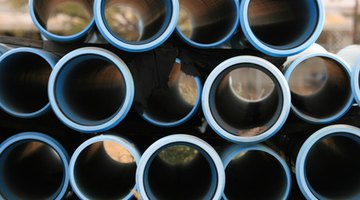Working With PVC: Sanding
Polyvinyl chloride, or PVC, is a plastic building material that comes in sheets or pipes. The pipes are most commonly used for plumbing work, but can be implemented in other building or craft projects. Although PVC pipes come in several sizes, you may need another a size not available off the shelf.

You could also want to remove the manufacturer's markings before installing the pipes, or smooth any rough cut edges. Sanding the pipes will help you accomplish these tasks, and the same techniques can be applied to sheets of PVC as well.
Tip
Sanding with a rough-grit paper can create grooves in the PVC. Use this to your advantage when gluing pieces together, since this creates more traction for the glue and more area for it to bond to. If your cut edges have large chunks or burrs, you can cut those pieces off with a knife before sanding.
Warning
Wear protective goggles and a respirator when sanding PVC. Sanding creates a dust of plastic particles that is dangerous to get in your eyes and lungs.
To Remove Markings
-
Cut the PVC to the size you need. This will make it easier to work with because the smaller pieces will be less cumbersome than the whole pipe or sheet.
-
Sand the entire surface with fine-grit sandpaper or sanding pads. Use a flexible sanding pad to curve the sandpaper around a pipe. This will remove the markings faster and in a more even fashion than sanding a bit at a time with a flat sander.
-
Clean the PVC by brushing it with a dry cloth. This will remove the sanded dust and give you a clean surface.
Sanding Down to Another Size, or Sanding Rough Edges
-
Cut the PVC to the length you need. Again, working with smaller pieces will be more comfortable for you.
-
Set up your work area. Sanding PVC down more than the amount required for removing outer marks can be extremely time-consuming and tiring by hand, so it is best to work with a machine sander. If you are working with a large machine, set it up and check the sanding belts or paper before you begin. If you are working with a smaller machine, such as a hand drill with a sanding bit, secure your PVC in a clamp so it will not move while you are working.
-
Sand the PVC a little bit at a time until you get the desired results. PVC heats up when it is sanded, from the friction. This can cause the PVC to warp, which can ruin your project or endanger you, if it breaks and causes you to come in contact with the machine. Sand until it gets hot. Then take a break for it to cool a bit before moving on.
-
Remove the PVC from the machine or clamp and clean it with a dry cloth. Once you have the desired shape, edge or texture, you can complete your project.
The Drip Cap
- Polyvinyl chloride, or PVC, is a plastic building material that comes in sheets or pipes.
- Cut the PVC to the size you need.
- If you are working with a smaller machine, such as a hand drill with a sanding bit, secure your PVC in a clamp so it will not move while you are working.
- Then take a break for it to cool a bit before moving on.
- Remove the PVC from the machine or clamp and clean it with a dry cloth.
Writer Bio
Nicole Whitney began writing professionally in 2008. She has authored in-house training documentation for quality assurance in insurance applications. With many credits coming from a stint in classics, Whitney holds a Bachelor of Arts in liberal studies from Assumption College.
Photo Credits
- Pipes and more pipes image by rider from Fotolia.com
- Pipes and more pipes image by rider from Fotolia.com
More Articles



